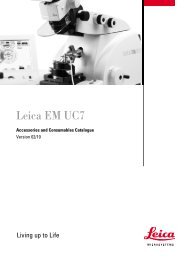Physical Principles of Electron Microscopy: An Introduction to TEM ...
Physical Principles of Electron Microscopy: An Introduction to TEM ...
Physical Principles of Electron Microscopy: An Introduction to TEM ...
Create successful ePaper yourself
Turn your PDF publications into a flip-book with our unique Google optimized e-Paper software.
Recent Developments 183<br />
one type <strong>of</strong> gun monochroma<strong>to</strong>r, in this case a Wien filter in which a<br />
magnetic field Bx and an electric field Ey are applied perpendicular <strong>to</strong> the<br />
beam, such that they introduce equal and opposite forces on the electron.<br />
The net force is zero when<br />
(�e)vBx + (�e)Ey = 0 (7.1)<br />
Equation (7.1) is satisfied only for a single electron speed v; faster or slower<br />
electrons are deflected <strong>to</strong> one side and removed by the energy-selecting slit.<br />
A convenient feature <strong>of</strong> the Wien filter is that the electrons allowed through<br />
it travel in a straight line, unlike a magnetic prism, which changes the<br />
direction <strong>of</strong> the optic axis.<br />
Monochroma<strong>to</strong>rs are expected <strong>to</strong> be useful for revealing additional fine<br />
structure in an energy-loss spectrum, as illustrated in Fig. 7-4. This fine<br />
structure can sometimes be used as a “fingerprint” <strong>to</strong> identify the chemical<br />
nature <strong>of</strong> very small volumes <strong>of</strong> material. In addition, good energy resolution<br />
is important for resolving energy losses below 5 eV, in order <strong>to</strong> measure the<br />
energy gap (between valence and conduction bands) in a semiconduc<strong>to</strong>r or<br />
insula<strong>to</strong>r and <strong>to</strong> investigate energy levels within the gap, which may be<br />
associated with localized defects such as dislocations.<br />
Figure 7-4. Part <strong>of</strong> the electron energy-loss spectrum recorded from a vanadium pen<strong>to</strong>xide<br />
sample using several FEI microscopes. The CM20 has a thermionic electron source, giving an<br />
energy spread <strong>of</strong> about 1.5 eV. The TF20 has a field-emission source and when fitted with a<br />
gun monochroma<strong>to</strong>r, it achieves an energy resolution below 0.2 eV, revealing additional fine<br />
structure just above the vanadium L-ionization threshold (� 515 eV). Although the energy<br />
resolution obtained by x-ray absorption spectroscopy (using synchrotron radiation) is even<br />
better, the <strong>TEM</strong> <strong>of</strong>fers greatly superior spatial resolution. From D.S. Su et al., Micron 34<br />
(2003) 235�238, courtesy <strong>of</strong> Elsevier Ltd. and F. H<strong>of</strong>er, Technical University <strong>of</strong> Graz.



